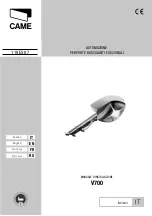
Section 4: Operation with Automatic Gas Console
Spirit II User’s Manual
This information is subject to the controls of the Export Administration Regulations [EAR]. This information shall not be provided to
non-U.S. persons or transferred by any means to any location outside the United States contrary to the requirements of the EAR.
4-8
Piercing Thick Materials
Care must be taken when piercing thick materials in order to prevent damage to the
shield cap and nozzle. As with all thicknesses, the pierce height must be set high
enough so the metal ejected while piercing does not come into contact with the shield
cap. Also, some of the material ejected during the pierce may adhere to the top side of
the plate and form a ring of solidified material around the pierce point.
Action must be taken so the torch does not move from the pierce height down to the
cutting height and come into contact with this solidified metal. The torch should not
move from the pierce height down to the cutting height until the X/Y controller has
moved the torch away from the pierce point.
One way to accomplish this may be to program the pierce time on the torch height
control system to a value that is longer than the X/Y controller motion delay time.
Moving Pierces and Edge Starts
On very thick materials, an edge start or moving pierce may be required to prevent
damage to the torch consumables.
With a moving pierce, the X/Y machine should begin moving at approximately 5–10
inches/minute (125–250 mm/min) as soon as the arc transfers to the plate. After the arc
completely penetrates the plate, the torch should be positioned at the proper cutting
height and the X/Y machine speed should be increased to the correct level.
With an edge start – the edge start required icon ( ) will appear at the top of the
screen – the torch should be positioned at the edge of the material prior to starting the
arc.
















































